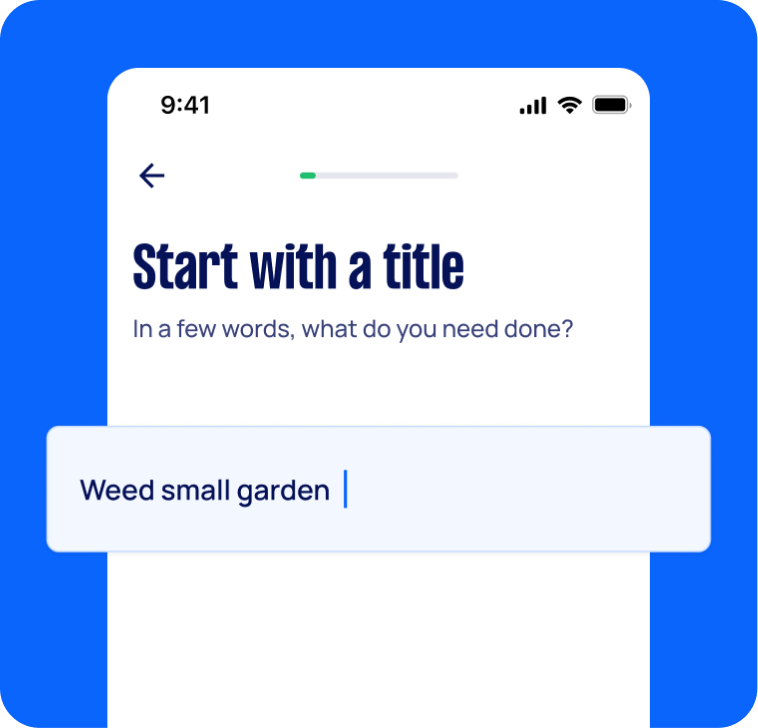Find a professional interior wall cladding contractor near you
Fill in a short form and get free quotes for professional interior wall cladding services
Need help with interior wall cladding?
- Interior wood cladding
- Interior feature wall cladding
- Shiplap wall cladding
- Beadboard wall cladding
- Interior cladding for wet areas
- … or anything else
What is Airtasker?

Post your task
Tell us what you need, it's FREE to post.

Review offers
Get offers from trusted Taskers and view profiles.

Get it done
Choose the right person for your task and get it done.
Why book interior wall cladding services through Airtasker?
It’s easy to book interior wall cladding services near you that deliver on the quality you require via Airtasker. Have wooden interior panels installed in different places at home that need that cosy vibe, from the living room to your private quarters. Inject a splash of warmth with an earthy ambience that would make your house feel more like home.
Got budget limits with your specific requirements in mind? We can match you with capable Taskers that can handle the job despite the added challenge. You can even get a free quote from interested Taskers and choose from various offers that best suit your needs.
Forget about browsing through an endless list of online ads and websites. Have a Tasker come to your aid instead. It’s as easy as putting up a task and waiting for their offers to arrive. Get your interior wall cladding started today!
Stay insured
Take your pick of Interior Wall Cladding experts near you.
Flexible pricing
Choose the offer that’s right for you.
Get the best taskers
Judge for yourself – every task gets a review.
Quick offers
Start getting offers to do your task ASAP!
Top Interior Wall Cladding related questions
Apart from shiplap and beadboard cladding mentioned earlier, there are other kinds of interior wall panelling that your Tasker can apply to many areas in your home. Different styles include v-groove (for colonial-era styling), board and batten, drop siding, rustic planking (for that aged patina finish), and more. You may discuss your options with your Tasker for more details.
Just regularly clean the panels with a microfibre cloth and some warm, soapy water. Do not use abrasive materials on your cladding to avoid scratches on the surface. Manage spills and stains quickly so as not to cause permanent damage when left unattended. An annual treatment might be necessary for interior wood claddings to lessen the chances of decay starting.
There’s no average timeline determining how long it would take to finish interior wall cladding projects. There are many factors to consider when gauging timelines, such as the size of the room, the style you want to apply, the materials needed for the project, and some time-saving measures should you need them. It is best to ask your Tasker for more details.
If you take care of your interior wall claddings with proper maintenance and the occasional treatment, they should last you a lifetime. As for the replacement, there’s no way to gauge except with a periodic inspection. When you see signs of decay or wear, it would be best to consult with Taskers to inspect your claddings. From there, they can recommend whether to take the replacement route, repair, or a simple treatment application.
Related Services near me
What do interior wall cladding services include?
With the rise of more sustainable and recycled options, interior wall claddings are becoming a thing again. You can have your home fitted with these via Airtasker! Renovation trends come and go, and it’s once again the time of retro classics to come back in style. You can choose from a variety of internal wall cladding materials that fit both your needs and budget. Here are some types of interior wall cladding installation services you can book on our platform:
Wood cladding
Wood claddings can cover plenty of surfaces in your home. From solid oak stair claddings to internal wall claddings, you’ll need to properly assess the scope of your project before you undertake any installation. Qualified wall cladding installers will first do a proper inspection of the site from flooring to ceiling, be it your everyday home or an occasionally visited summer house where internal cladding is needed.
Interior wall claddings are typically made of wood, but this just scratches the surface. Plywood, reclaimed wood, solid wood, fiberboards–there’s a lot more to choose from that should cater to your project’s needs. To see how materials can affect the cost, the longevity of your installation, and how they’ll impact the design, feel free to ask your Tasker for more details.
Shiplap wall cladding
Shiplap is a classic wall cladding style that’s actually a type of joint. Shiplap panels are made of horizontal wood slabs rabbeted along their sides for a tight, interlocked seal. Going for shiplap wall cladding suits more rustic tastes, perfect for suburban-style rooms and garden sheds!
Taskers will first assess the project’s complexity depending on existing installations, insulation requirements and overall design that you want to have. They will then take exact measurements of areas covered by the build to ensure proper fit before finishing the interior touches.
Beadboard wall cladding
Beadboards look like they have this bead-like division between boards from the surface, but this is actually to hide the actual joints that keep them all together. This forms a seamless look for your wall. You can save time with other material options for this particular wall cladding style. It would be best to ask your Tasker for more details about this route for beadboard wall claddings.
Interior cladding for wet areas
While interior wood cladding is normally seen as incompatible for wet areas like bathrooms, you can also opt for certain types of wood if you genuinely wish for a unique, rustic look for them. While shower and bath enclosures require cladding that can better stand up to constant exposure to moisture, you can opt for wood planks and plywood for areas like the sink as they fare better than other wood materials by being able to swell better with water. However, it isn’t recommended for shower and bath enclosures as those would be a more costly endeavour with the need to replace them more often due to less water resistance than tiles and PVC.